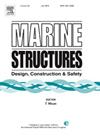浮式结构全耦合综合荷载分析的模态矩阵简化
IF 5.1
2区 工程技术
Q1 ENGINEERING, CIVIL
引用次数: 0
摘要
在综合荷载分析(ILA)中,浮式风力发电机组的结构弹性通常采用简化的梁模型对子结构进行建模。其主要原因在于求解全耦合水弹性问题时结构求解器的计算成本。本文采用基于模态矩阵约简的降阶方法来降低结构求解器的计算量。其主要思想是通过只保留那些具有显著能量的模态来大大减少结构系统的自由度。采用有限元框架SeaFEM求解船体的耐波水动力问题。结构特性被引入到这个框架中,以充分整合流固耦合。水弹性模型还与风力涡轮机求解器OpenFAST相结合,形成了一个完整的气动-液压-伺服-弹性工具,用于浮式涡轮机的ILA分析。提出了一种基于结构能量的临界工况和热点识别方法。最后给出了该策略在著名的OC4-DeepCwind的详细结构设计中的应用实例。通过有限元结构解验证了模态近似和方法的一致性。所提出的ILA框架的能力在完全耦合和详细的结构分析中得到了证明,而不是在组件级别,大大减少了计算时间。本文章由计算机程序翻译,如有差异,请以英文原文为准。
Modal matrix reduction for fully coupled integrated load analysis of floating structures
Structural elasticity of floating wind turbines in integrated load analysis (ILA) is typically addressed by modelling the substructure with simplified beam models. The main reason can be found in the computational cost of the structural solver when solving the fully coupled hydroelastic problems. In this work, a reduce order method based on modal matrix reduction is applied to reduce the computational cost of the structural solver. The main idea is to largely reduce the number of degrees of freedom of the structural system by retaining only those modes with significant energy.
The seakeeping hydrodynamics is solved using the finite element framework SeaFEM. The structural particulars are introduced into this framework to fully integrate the fluid-structure interaction. The hydroelastic model is also coupled with the wind turbine solver OpenFAST, resulting in a complete aero-hydro-servo-elastic tool for the ILA analysis of floating turbines.
A methodology is proposed to identify critical conditions and hotspots based on the structural energy. An application case of the present strategy is presented for a detailed structural design of the well-known OC4-DeepCwind. The consistency of the modal approximation and methodology is verified against the FE structural solution. The capabilities of the proposed ILA framework are demonstrated in a fully coupled and detailed structural analysis, instead of at component level, with a significant reduction of its computational time.
求助全文
通过发布文献求助,成功后即可免费获取论文全文。
去求助
来源期刊

Marine Structures
工程技术-工程:海洋
CiteScore
8.70
自引率
7.70%
发文量
157
审稿时长
6.4 months
期刊介绍:
This journal aims to provide a medium for presentation and discussion of the latest developments in research, design, fabrication and in-service experience relating to marine structures, i.e., all structures of steel, concrete, light alloy or composite construction having an interface with the sea, including ships, fixed and mobile offshore platforms, submarine and submersibles, pipelines, subsea systems for shallow and deep ocean operations and coastal structures such as piers.
 求助内容:
求助内容: 应助结果提醒方式:
应助结果提醒方式:


